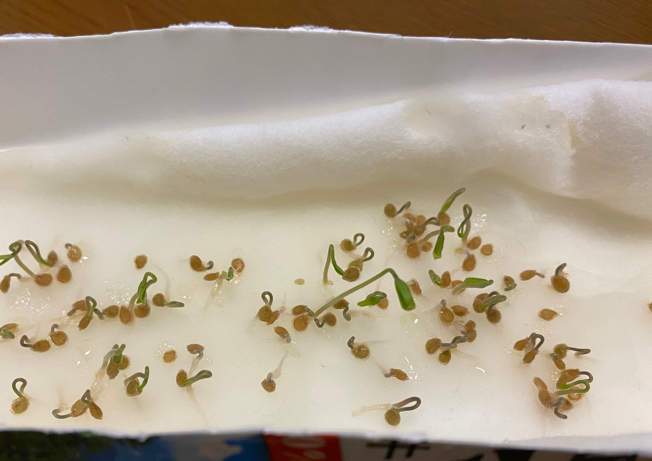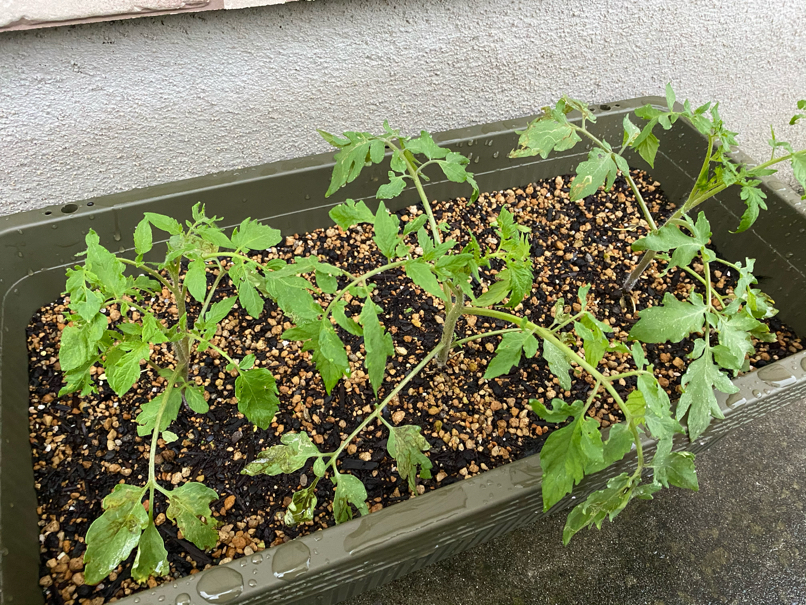
Fresh, juicy, and sweet tomatoes are delicious and easy to grow at home, aren’t they?
While growing cherry tomatoes in a planter is convenient, I also want to try growing larger tomatoes.
Feeling this desire bubbling up inside me, I’ve decided to give it a try.
Buying seedlings and just watching them grow isn’t as exciting, so I want to try growing them from seeds… but starting from seeds seems difficult.
You might have this impression, but after cultivating tomatoes from seeds for nearly five years, I’ve learned some tricks, and now it doesn’t seem so challenging anymore.
So, in this article, I’ll discuss whether it’s difficult to grow tomatoes from seeds and share methods for germinating tomatoes from seeds.
How to take seeds of ripe cucumber

Gathering Tomato Seeds for Germination

Let’s start by collecting tomato seeds.
You can use tomatoes bought from the supermarket; just scoop out the seeds before eating.
For a home garden, having about 10 plants is enough for a decent harvest, so let’s collect around 20 tomato seeds.
With this alone, you’re almost ready to germinate and grow tomatoes from seeds.
Wash away the fruit pulp around the tomato seeds

The tomato seeds are surrounded by jelly-like fruit pulp, so I rinse and remove as much of it as possible.
Similar to germinating kiwi seeds, I couldn’t find a definitive source regarding germination-inhibiting substances in tomatoes. However, since tomato juice may contain such substances, it’s better to thoroughly wash away the fruit pulp.
I found that transferring the seeds to a sieve and gently rubbing them with my fingertips helped remove the fruit pulp easily.
With cherry tomatoes, you need to be careful because the seeds are a bit small. However, for medium or large tomatoes, the seed size is larger than the mesh of the sieve, making them easier to wash.
Sow the tomato seeds onto dampened kitchen paper

After washing away the fruit pulp of the tomato seeds, sow them onto dampened kitchen paper.
Tomato seeds are photophobic, so if you’re planting them in soil, be sure to cover them with a layer of soil.
When growing them on kitchen paper, you can simply cover them with aluminum foil to block out light.
While leaving the seeds exposed on the kitchen paper won’t prevent germination, it’s still recommended to cover them with aluminum foil since tomatoes are photophobic seeds.
Tomato seeds have a high germination rate and germinate relatively quickly, so if you’re sowing them on kitchen paper, be sure to check them frequently, ideally every day.
If you leave them too long, the roots may grow too long, making it difficult to remove them from the kitchen paper.
It’s recommended to transplant them into seedling pots once they start to sprout.
Two days after sowing the tomato seeds: Confirmation of germination

Only two days after sowing the seeds onto the kitchen paper, I’ve confirmed germination from a significant number of tomato seeds.
I didn’t place them in a dark location this time, so it seems that even though they are photophobic, it’s not always necessary to keep them in the dark.
I’ll continue to let them grow on the kitchen paper until the seedlings develop further.
Four days after sowing the tomato seeds: The seedlings have grown significantly

On the fourth day after germination:
The tomato seedlings have grown significantly, reaching a point where they are about to unfurl their first true leaves.
Although there’s some variation, the germination rate is roughly around 80%, which is quite impressive.
Every year, I germinate tomato seeds on kitchen paper before transplanting them into seedling pots, and I find tomatoes to be one of the easiest summer vegetables to cultivate due to their quick germination and high success rate.

Since the tomato seedlings had grown to a certain extent, I decided to transplant them into seedling pots. However, the roots had unexpectedly extended quite a bit and had become entangled in the kitchen paper.
Tomatoes have vigorous growth, so if left on the kitchen paper for too long, the roots can become entwined, making removal quite troublesome.
While tomato roots can tolerate some damage, considering their growth, it’s best to transplant them into seedling pots as soon as germination is confirmed to avoid any negative effects on growth.
In this case, I managed to successfully transfer them into pots by tearing the kitchen paper along with the seedlings.
Two weeks after sowing the tomato seeds: Beautiful true leaves have developed

When transplanting tomato seeds germinated from seeds, some of the roots were accidentally torn off during the process, but they managed to establish themselves successfully.
They’ve grown into beautiful cotyledons.
Since the germination rate was quite high, I couldn’t transfer all the tomato seedlings from the kitchen paper to pots at once. However, I noticed differences in growth when the timing of transplanting into soil was delayed.
The lack of nutrients for growth promotion, due to the kitchen paper providing only moisture, likely caused this discrepancy.
Once germinated, exposing the tomato seeds to sunlight immediately after germination can have a positive impact on their growth. So, it’s advisable to transplant them from the kitchen paper as soon as they germinate.
One month after sowing the tomato seeds: The stems have grown thicker, and they have developed to the point where the first flowers are about to bloom

After one month since the tomatoes sprouted, they have grown quite impressively.
They’re almost ready to bloom with their first flowers.
They’ve grown to a level even more robust than the seedlings you’d find at a garden center, so as long as I continue to prune the side shoots diligently, everything should be fine.
I’m a bit worried about planting three of them in this size of a planter, but for now, I’ll focus on training one into a neat single stem.
I tend to forget about pruning side shoots, so I’ll need to make sure not to slack off on that.
After 1.5 months since planting the tomato seeds, I forgot to prune the side shoots, and as a result, they have grown lush and dense

Due to continuous heavy rain and other factors, I couldn’t take care of the tomatoes properly, and as a result, the side shoots grew uncontrollably.
Being seeds from tomatoes served at the table, their original appearance was unknown, but they’ve grown significantly larger.
They’re noticeably different from cherry tomatoes based on leaf size.

The tomato plants have started to bloom sporadically.
Since producing the first fruit is a crucial step towards a bountiful harvest, I want to nurture them carefully.
Nutritional growth and reproductive growth
- Nutritional growth: thickening stems and lush foliage
- Reproductive growth: blooming flowers and bearing fruit
In this growth process, there are two distinctions, and in the case of tomatoes, encouraging reproductive growth by bearing fruit from the first flower helps promote fruiting. This means it becomes easier for the plant to bear fruit.
However, this can also affect the overall growth of the plant, so it’s important to assess the condition of the seedlings as well.
I’m hoping the first flowers bear fruit abundantly because I aim to harvest a large quantity.
However, it seems there are fewer insects around lately.
Could this be due to the soaring temperatures of midsummer?
I’m a bit concerned, but I’ll observe a little longer.
Tomatoes can easily be grown from seed and nurtured to maturity
This time, we introduced the germination method for growing tomatoes from seeds.
Tomatoes are one of the most popular summer vegetables, and while they are readily available in their ripe, red state, starting tomatoes from seeds you’ve collected is highly recommended.
Tomatoes grown from seeds and harvested tend to taste more flavorful due to the effort put into their cultivation compared to those bought as fruits or grown from seedlings.
Their taste remains mostly unchanged, and in fact, freshly harvested tomatoes might even taste better.
Since tomatoes can easily be germinated from seeds on a piece of kitchen paper, the initial hurdle to starting is quite low, which is a significant advantage.
Growing tomatoes from seeds is not particularly difficult, so for those interested, I highly recommend giving it a try.
How to take seeds of ripe cucumber

How to make seedlings of the sweet potato



コメント